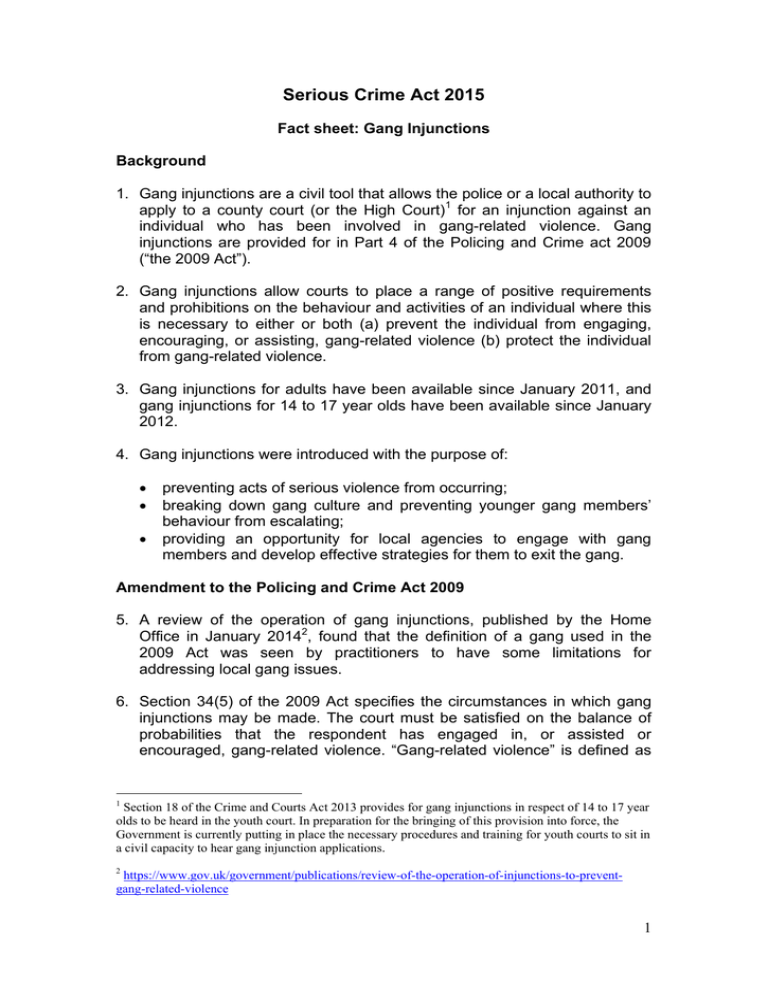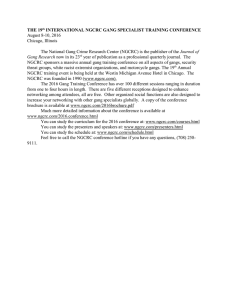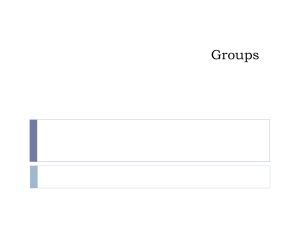Gang Injunctions
advertisement

Serious Crime Act 2015 Fact sheet: Gang Injunctions Background 1. Gang injunctions are a civil tool that allows the police or a local authority to apply to a county court (or the High Court)1 for an injunction against an individual who has been involved in gang-related violence. Gang injunctions are provided for in Part 4 of the Policing and Crime act 2009 (“the 2009 Act”). 2. Gang injunctions allow courts to place a range of positive requirements and prohibitions on the behaviour and activities of an individual where this is necessary to either or both (a) prevent the individual from engaging, encouraging, or assisting, gang-related violence (b) protect the individual from gang-related violence. 3. Gang injunctions for adults have been available since January 2011, and gang injunctions for 14 to 17 year olds have been available since January 2012. 4. Gang injunctions were introduced with the purpose of: preventing acts of serious violence from occurring; breaking down gang culture and preventing younger gang members’ behaviour from escalating; providing an opportunity for local agencies to engage with gang members and develop effective strategies for them to exit the gang. Amendment to the Policing and Crime Act 2009 5. A review of the operation of gang injunctions, published by the Home Office in January 20142, found that the definition of a gang used in the 2009 Act was seen by practitioners to have some limitations for addressing local gang issues. 6. Section 34(5) of the 2009 Act specifies the circumstances in which gang injunctions may be made. The court must be satisfied on the balance of probabilities that the respondent has engaged in, or assisted or encouraged, gang-related violence. “Gang-related violence” is defined as 1 Section 18 of the Crime and Courts Act 2013 provides for gang injunctions in respect of 14 to 17 year olds to be heard in the youth court. In preparation for the bringing of this provision into force, the Government is currently putting in place the necessary procedures and training for youth courts to sit in a civil capacity to hear gang injunction applications. 2 https://www.gov.uk/government/publications/review-of-the-operation-of-injunctions-to-preventgang-related-violence 1 violence or a threat of violence which occurs in the course of, or is otherwise related to, the activities of a group that: consists of at least 3 people; uses a name, emblem or colour or has any other characteristic that enables its members to be identified by others as a group; and is associated with a particular area. 7. Following consultation with practitioners from the police and local authorities, we have concluded that this definition is unduly restrictive and more importantly, does not reflect the true nature of how gangs operate in England and Wales. In particular: gangs do not always have a name, emblem or colour or other characteristic which enables its members to be identified as a group. Instead, a group of individuals may operate as a group and engage in criminality with some degree of organisation without these features; gangs are increasingly involved in criminality beyond their own areas and can be less associated with a particular area in a firm way. Gang structures change over time such that it is possible for gangs to disappear from certain locations and re-appear in other locations within the United Kingdom relatively quickly. This can be a result of gangs moving to other locations as a result of black market forces or being pushed out by rival gangs. 8. Section 51 of the Serious Crime Act 2015 amends the 2009 Act to revise the definition of “gang-related violence”. Henceforth, something is gangrelated if it occurs in the course of, or is otherwise related to, the activities of a group that: consists of at least 3 people; and has one or more characteristics that enable its members to be identified by others as a group. 9. In addition, evidence from police and local authorities shows that urban street gangs often engage in street drug dealing on behalf of organised criminals, and some gangs aspire to and may become organised crime groups in their own right. This is why we are expanding the activity in relation to which gang injunctions can be imposed to involvement in the drugs market. This will allow gang injunctions to be used to prevent individuals from engaging in illegal drug dealing, with positive requirements available to divert people away from the gang and protect them from being further drawn into drug dealing activity; this is particularly important for vulnerable persons, in particular younger teenage children. Home Office March 2015 2 Gang Injunctions: Case Study During 2011 the police recorded a series of serious incidents in one district of a large city including firearm discharges, kidnappings, assaults and two gang murders. Intelligence linked the violence to a group of young people who were known to congregate around one particular park. Despite police action to disrupt the group’s drug dealing activity which was the cause of the violence and which resulted in two convictions, the group still remained a problem. In January 2012, the gang split into two groups which began targeting each other and their families. Police activity continued, but due to reluctance from local people to make criminal complaints or to come forward as witnesses, the violence continued and the police decided to take an alternative approach. In July 2012, an ex parte hearing took place at the County Court at which 12 interim gang injunctions were granted in respect of the main gang members. Each gang member had 10 prohibitions and two requirements placed upon them, including not entering certain specified areas and streets, not communicating with certain named individuals and a prohibition on travelling in a motorised vehicle with two or more people except in a taxi or on public transport. The injunctions had an immediate impact locally - the violence disappeared; their families started to engage with the police, and the community started to use the park again. Full injunctions were granted in May 2013; none of which were contested. Numerous arrests were made for breaches of the injunction which were followed through with custodial sentences. Whilst some of the gang members have complied with the injunction and used it as an opportunity to start a new life, others have left the city and have been encountered by the police in other areas. However, the violence previously linked to the gangs has not returned and the police have been able to redirect their resources. 3


